Charleston Currents #11.21 | April 1, 2019
BIG GATOR. We spotted this alligator when walking on a path at Kiawah Island and quick moved away. It was huge — at least 12 feet long! Thank goodness it returned quickly to a lagoon instead of feasting on Bracks. (Photo by Andy Brack.)
 FOCUS, Gray: On disruptive companies and policymakers impacting change
FOCUS, Gray: On disruptive companies and policymakers impacting change
COMMENTARY, Brack: Saluting a true blue son of The Citadel
IN THE SPOTLIGHT: Titan Termite & Pest Control
PALMETTO POEM: Where your soul belongs, by Matthew Foley
GOOD NEWS: Share your Charleston story about restaurant integration
FEEDBACK: Mountain wildflowers are beautiful
MYSTERY PHOTO: Look familiar?
S.C. ENCYCLOPEDIA: Jasper County
CALENDAR: Pets to be focus of special Charleston Museum exhibition
FOCUS: On disruptive companies and policymakers impacting change
By Allyson Sutton, special to Charleston Currents | Whether crafting outreach for major brands or leading political campaigns for U.S. senators, Matt McKenna and Taylor Bennett have equally impressive backgrounds in communications and public affairs. [More than 2,000 people will attend the DigSouth summit later this month.]
For over seven years, Matt served as spokesperson and senior adviser to President Bill Clinton and the Clinton Foundation. He also ran communications for Uber North America and spearheaded several political campaigns for governors and senators around the country. Two years ago, Matt co-founded Greenbrier, a San Francisco-based consultancy that helps individuals and organizations avoid, navigate and recover from complex media, political and legal challenges.
Taylor spent the first half of his career at Edelman and Adfero, where he managed reputation campaigns for leading brands like Walmart and American Airlines. He later served as Communications Lead at Uber during its early expansion and as Head of Communications for global bikeshare leader of North America. Now, Taylor works as Director of Public Affairs at Lime, steering the brand’s growth through city collaboration.
When we said “impressive,” we meant it. We’re thrilled to invite these two innovators on-stage at the DIG SOUTH Tech Summit to share their take on why ‘move fast & break things’ is old thinking, and how industry disruptors and policymakers can work together to affect change.
Below, discover their best advice for taking a “permission-first” approach to innovation, how to foster startup and city collaboration, and what they think Silicon Valley and Washington, DC can learn from each other in 2019.
Q: We’ve seen several disruptive companies get into hot water by not initially collaborating with policymakers. What’s your best piece of advice for companies navigating an image or legal challenge?
Be honest, human and transparent. Understand this is a two-way relationship and work to foster that partnership by providing real value.
To the first point, regulators, consumers and the media are sharper than ever. The days of spinning facts or a company’s true intent with buzzwords are over, because they’ve seen and heard it all at this point. Honesty is the foundation for any positive, external relationship, or recovery from an image challenge. On the other hand, nothing exacerbates a negative story or legal challenge more than defiance or deception.
To the second point, when entering a new market or launching a new product, the old adage applies: you only get one first impression. Do you want to connect with decision-makers and users on a human level, or do you want to be seen as a black box? The former tends to lead to favorable rules and a welcoming regulatory environment, and receiving the benefit of the doubt when something goes wrong, while the latter can result in lingering animosity and being the target of future legislation that undermines your business model, even if you win a short-term battle for legality.
Some innovators may think asking for permission will slow their growth. Have you seen examples of a “permission-first” approach actually speeding up or enhancing innovation/growth?
Taylor: I’m very proud of the way Lime has taken a collaborative approach with cities, since day one. We understand the need to work together and the value of strong relationships. That permission-first model has enabled us to scale to over 100 cities in 5 continents in less than 2 years. Cities talk to each other and they know what sort of partner you’re going to be, and that can lead to greater and quicker adoption if you’re known for working together to craft the right program or service for that city.
Matt: The permission-first approach is not new. The reversion back to it is. For decades, innovative companies have first sought permission, and in doing so, ensured success prior to launch. Examples are seen throughout the banking, finance, energy and insurance industries.
 Could you share a couple of strategies for disruptive companies looking to partner with policymakers?
Could you share a couple of strategies for disruptive companies looking to partner with policymakers?
Open a direct line of communication. Policymakers want an open, fluid dialogue throughout the market entry process and subsequent operational phase. Whether it’s simple product questions, early issues that arise, or even crafting legislation together, regulators knowing they have someone to call or email on a whim goes a long way.
Share your data. Policymakers are tasked with improving their communities, while most companies operating in their regions are collecting invaluable insights and data on their constituents. Recognizing the value those insights can provide cities and sharing that data–while protecting consumer privacy–fosters good will and makes their job easier.
Let’s use Lime as an example to illustrate this point. Naturally, we collect data on commuting patterns. On the other hand, cities are constantly trying to improve commutes and encourage fewer cars on the road to reduce pollution and congestion. Offering our insights can help inform infrastructural decisions such as where to build bike lanes, how to best time traffic lights, and much more.
Let’s help these two groups walk a mile in each other’s shoes for a minute. What do the disruptors need to understand about cities and/or regulators to best foster collaboration?
Even if a city and company’s objectives do not align, cities are never a company’s adversary, and their initial goal is never to foil a company’s expansion plans out of spite. Elected officials are motivated by three primary factors when assessing disruptive companies moving into their city:
- Does this solve a key challenge and improve my community and the daily lives of residents?
- Does this align with the wishes of my constituents, who in most cases, will need to reelect me within the next two years?
- Does this align with the values of my political party?
If you walk into a meeting or public hearing without a sound answer and solution to any of these questions, expect to leave disappointed.
On the flip side, what should cities/regulators understand about the disruptors? How can they welcome these new technologies into their communities?
The important perspective regulators should maintain when dealing with disruptors is why they exist in the first place. There was a preexisting pain-point for individuals and/or communities, and the disruptive technology was designed to solve it. Whether it’s Lime connecting commuters with first and last mile transportation solutions to avoid congestion, or Uber getting passengers from point A to point B at the tap of a button, there is usually an underlying value proposition to disruptive technologies that make them so popular with users (who double as an elected official’s constituents).
You both led communications and public affairs at Uber, helping the unicorn expand globally in a regulatory-compliant way. Any advice for organizations looking to grow quickly without breaking all the rules?
It’s worth noting that in its earliest start-up days, Uber was not expanding in a regulatory-compliant way because there simply weren’t ridesharing rules in place. What’s really interesting about Uber’s rapid growth is that it wasn’t until the company dedicated time and energy to passing legislation and becoming compliant in every market that it really was able to expand effectively and consistently. In fact, the reputation Uber developed from its earliest days as a company unwilling to collaborate with cities took years to overcome and made the legalization process with cities more difficult than it had to be, even when we were coming to the table with a refreshed, cooperative mindset.
Matt, you’re based in San Francisco and Taylor, you’re in Washington, DC. In terms of innovation, what can the two markets learn from each other?
Matt: SF innovators could take some lessons in political tact from DC. Many DC-based companies work with the federal government and know how to play the game. Some SF companies, on the other hand (particularly startups that have not had to engage government before) often lack a basic understanding of how to approach regulators, how to influence regulators, and simple, traditional etiquette formalities such as how to address policymakers, how to format written responses, how to dress for City Hall hearings, what not to say, and much more.
Taylor: Washington is notorious for its inaction and regulators are often playing catch-up to the rapid pace of technological advancement. While San Francisco has embraced innovation and positioned itself as a true leader in technology, Washington policymakers could benefit from quicker decision making and a greater understanding and appreciation of the value of technology.
We’re thrilled to see you in Charleston this April. What are you most looking forward to about speaking at the DIG SOUTH Tech Summit?
We’re equally thrilled to be here. What’s most exciting is gathering in one place with some of the smartest innovators and decision-makers, hearing everyone’s perspectives and stories from the trenches, and applying those lessons to how we operate at Lime to help us serve our users and communities even better.
Ever wish you could pick the brain of a tech unicorn executive or presidential spokesperson?
Now you can. Don’t miss your chance to learn directly from Matt McKenna and Taylor Bennett during the DIG SOUTH Tech Summit this April. Their engaging session, Why ‘Move Fast & Break Things’ is Now Old Thinking: How Lime is Approaching Regulation with Collaboration, will give innovators a firsthand look at how to drive lasting change without breaking all the rules.
- Have a comment? Send to: editor@charlestoncurrents.com
BRACK: Saluting a true blue son of The Citadel
By Andy Brack, editor and publisher | Word came early Wednesday that was expected but not welcome: A good friend, Carroll LeTellier, passed away peacefully that morning.
 We were an unlikely pair — a 57-year-old liberal writer and a 90-year-old retired Army general who was a child of The Citadel and who didn’t hang out much with my kind.
We were an unlikely pair — a 57-year-old liberal writer and a 90-year-old retired Army general who was a child of The Citadel and who didn’t hang out much with my kind.
For the last several years, the general, I and a few other former military types have had a standing Saturday breakfast at the Marina Variety Store along the Ashley River. We chew the fat of the day. They rail about Democrats. I tell them they’ll have another heart attack or health emergency if they keep feeding their Fox news addiction. Conversation is easy, generally not mucked up by politics. Friendships are real.
The general ordered the same thing every week — two eggs over easy, grits, sausage and an English muffin, no coffee. He was so predictable about breakfast that our server, Mary, simply asked weekly, “Number four for you?” even though there was no number four on the menu. He’d nod, periodically inquiring whether the grits were good on that particular day. (The man loved creamy grits.)
For the past few years since the general decided to stop driving, I’d pick him up at 8:10 a.m. sharp. He’d be ready, reconnoitering the street for my arrival, promptly opening the front door of his West Ashley home and slowly walking down the steps. He’d soon open the door and thrust in his hand for a shake with a warm but crisp, “Good morning, how’s your week been?”
And so we’d be off — literally and figuratively. As we headed to the restaurant, we’d catch up about what had happened over the last week — an ailment, a family happening, something in the news. He’d always inquire about my daughters.
After breakfast with the guys, we’d head over to my post office, where he’d cross fingers that there would be some checks in the mail from clients. Along the way, he might recall walking to his elementary school on upper King Street where he’d save some of his lunch money to buy penny candy. Or, he’d bring up something about the Ravenel Bridge as we passed an office he had while it was being built. I’d learn about his beloved Citadel, where he grew up a son of Louis S. LeTellier, who joined the college faculty in 1908, 20 years before the general was born. He was a son proud of his father, who became head of the school’s civil engineering department, served as acting president of the institution in 1953, and later was its dean. LeTellier Hall is named for Louis LeTellier.
A few weeks before the general died, he was visited by another general, the new president of The Citadel, Marine (Ret.) General Glenn M. Walters. They got to know each over in a two-hour visit that was more than the perfunctory courtesy call. The visit meant a lot to LeTellier.
“Maj. Gen. Carroll LeTellier is revered by The Citadel community,” Walters said in an online tribute. “He served in the U.S. Army Corps of Engineers for almost three decades, was known for his engineering designs and direction related to major projects around the nation including the Ravenel Bridge in Charleston, and served in numerous capacities as a leader on campus. He will be greatly missed.”
Carroll Nance LeTellier, class of 1949 at The Citadel, served 27 years with the Army in the Corps of Engineers. He was deployed six times, including during three conflicts in Korea, Lebanon and Vietnam. Bearer of a master’s degree in civil engineering from MIT, he also served as the Corps’ district engineer in St. Louis and division engineer in Atlanta. In the service, he earned the Distinguished Service Medal and five other awards, including the Legion of Merit, the Bronze Star and the Air Medal.
“Carroll was a two-star general with a solid chance to be the Army’s chief of engineering and wear a third star when he was stricken with cancer,” recalled a Marine friend, retired Lt. Col. Fred Whittle, a former president of The Citadel Alumni Association. “Still, he lived 44 years more and outlived his two peer generals who did achieve the Army billet he might have had.”
After retiring in 1976, LeTellier had a long engineering career in the private sector as vice president of Sverdrup Corporation where he oversaw the design, construction and upgrades for physical and technical security at 44 U.S. embassies around the world. In his final four years, he is credited with creating the preliminary designs for the cable-stayed Ravenel Bridge over the Cooper River.
The general and his wife, Mississippi-born Frances Melsheimer LeTellier, were married 63 years. They had four children, including a son Francis R. Letellier who was a member of The Citadel’s class of 1985. He, as well as a daughter, Norma Louise, and a son, Carroll Jr., died before their parents. Mary C. LeTellier, a daughter, lives in Charleston.
“Carroll was a faithful, loving husband and father, a stellar Army officer, and an accomplished business executive but also, the most ardent of supporters for The Citadel and The Citadel Alumni Association,” said the association’s controller, Rick Raybon. “His vision, leadership and determination has helped insure the success of both for decades to come. The Holiday Alumni Center and Hollings Hall stand as a memorial to this selfless and untiring devotion to these institutions.”
The general loved his family, his college, the military, his friends and his church, Grace Church Cathedral which he attended throughout his life in Charleston. In recent years, he sat on the back row on the right side. We’ll miss seeing his broad smile and outstretched hand as we walk to communion. His funeral will be 2 p.m. Wednesday at Grace.
Maj. Gen. Carroll Nance LeTellier, 1928-2019. Rest in peace.
- Have a comment? Send to: editor@charlestoncurrents.com
Titan Termite & Pest Control
 Titan Termite & Pest Control, headquartered in Charleston, is a full service residential, commercial and industrial pest control company serving South Carolina. It is a third-generation, family-owned company known for outstanding customer service. Each associate is dedicated to the customer and exhibits integrity and respect. Titan’s pest professionals can assist your commercial or residential location with general pest control, termite inspections, termite control, flea control, bed bug extermination, ant control and more. Titan Termite and Pest Control continues to set high standards so that its customers receive the best possible service. Titan’s technicians are knowledgeable of the latest in pest control techniques, which enables the company to customize effective treatment plans for every situation.
Titan Termite & Pest Control, headquartered in Charleston, is a full service residential, commercial and industrial pest control company serving South Carolina. It is a third-generation, family-owned company known for outstanding customer service. Each associate is dedicated to the customer and exhibits integrity and respect. Titan’s pest professionals can assist your commercial or residential location with general pest control, termite inspections, termite control, flea control, bed bug extermination, ant control and more. Titan Termite and Pest Control continues to set high standards so that its customers receive the best possible service. Titan’s technicians are knowledgeable of the latest in pest control techniques, which enables the company to customize effective treatment plans for every situation.
-
- Free estimate: 888-794-5603.
- Contact Titan online.
- To meet all of our underwriters, click here.
POEM: Where Your Soul Belongs
By Matthew Foley, special to Charleston Currents
![]() I know you’ve heard it
I know you’ve heard it
all the days of your life.
A voice,
quietly calling.
A song,
for your ears alone.
Over and over again,
it has called your name,
pulled you like the moon
calls home the tide.
It has drawn you
to the quiet places,
to green woods
and rushing rivers,
to holy mountains
and deep solitude.
Only in that silence,
can you hear
what it has to teach.
Like bird song
on the wind,
it whispers:
you are free
to leave behind
all that has become
too heavy for your heart.
I know you are scared
to unclench your hands
and finally let go.
You will lose much,
dear one,
maybe everything,
on the way to your soul.
The caterpillar
knows the cocoon
means death,
the end of everything
it once was.
You must die
to every life
not meant for you
if you want to birth
a butterfly.
Your wings await you
across the river
and through the trees,
to that far country
where the voice
has always called you.
May you follow it,
wherever it may lead.
May you follow it,
to the place
where your soul belongs.
Matthew Foley is an author, spoken-word poet, writing coach and creative entrepreneur in Charleston. More: MatthewFoleyPoetry.com
Share your Charleston story about restaurant integration
Staff reports | The Charleston County Public Library wants to hear stories about restaurant integration in the area. Partnering with The Post and Courier newspaper, the library is seeking to document people’s earliest memories of dining in white-owned restaurants.
“Up until now, these important stories have gone undocumented, creating a major gap in how scholars and diners understand Southern restaurant culture,” food editor Hanna Raskin said in a news release. “We hope this effort will help to restore facts, feelings and reflections to their rightful place in Charleston dining history.”
The library is hosting four recording sessions at three of its branches. At each session, participants will be interviewed individually and in private about their experiences with Charleston food service establishments before and after integration.
“Nothing will be published without the interviewee’s permission, and we can always pause or stop if they need a break,” said Raskin. “We appreciate that these stories are highly personal, and understand many people might not be inclined to share them.”
Anyone interested can attend one of the following sessions:
- April 1 from 5 p.m. to 7:30 p.m. at the Main Library, 68 Calhoun St., Charleston.
- April 2 from noon to 3 p.m. at the John’s Island Regional Library, 3531 Maybank Highway, John’s Island.
- April 3 from noon to 3 p.m. at the Hurd/St. Andrew’s Regional Library, 1735 N. Woodmere Dr., West Ashley.
- April 4 from 9 a.m. to 2 p.m. at the Main Library.
Also in Good News:
![]() Moustache movement. Here’s a way to have fun at the coming Cooper River Bridge Run and to remember the event’s race director, Julian Smith, who passed away in March: Wear a moustache to honor his 25 years of work on the run. Say race officials, “Grow one out, stick a fake mustache on your face, even draw one if you must. But on April 6, whether you are running the Bridge Run or not, sport your mustache proudly to honor the Charleston legend, Julian Smith and thank him for all he has done for our community.” #MustacheForJulian #crbr #crbr2019
Moustache movement. Here’s a way to have fun at the coming Cooper River Bridge Run and to remember the event’s race director, Julian Smith, who passed away in March: Wear a moustache to honor his 25 years of work on the run. Say race officials, “Grow one out, stick a fake mustache on your face, even draw one if you must. But on April 6, whether you are running the Bridge Run or not, sport your mustache proudly to honor the Charleston legend, Julian Smith and thank him for all he has done for our community.” #MustacheForJulian #crbr #crbr2019
Port growth. The S.C. Ports Authority reported banner February growth with a 12 percent increase over the previous February. The port 178,131 twenty-foot equivalent container units (TEU) during the month of February, with 1.6 million TEUs handled since the fiscal year began in July. “A strong February contributed to the Port’s continued growth, with container volume nearly six percent ahead of our financial plan for the first eight months of our fiscal year,” said SCPA President and CEO Jim Newsome in a press release. “We anticipate volumes from March to May will be below plan due to the impact of trade uncertainty and a significant number of blanked sailings, but we ultimately expect to achieve our FY2019 plan of 1.3 million pier containers.”
Justice rally. Charleston Area Justice Ministry will hold a 7 p.m. Aug. 8 rally at Mount Moriah Missionary Baptist Church, 7396 Rivers Ave., North Charleston. Why? To learn more about transportation and understand needs as it works to encourage public officials. “”We want a connected region where working families can afford to live with money left over for food, medicine and childcare, a region where working people rely on a public transit system that works for them,” according to an announcement. More info is online.
On selling Santee Cooper: We don’t like this idea, but there’s a sudden, fervent push to sell one of the nation’s few remaining public utilities that has roots in the early 20th century’s push to bring electricity to rural parts of South Carolina. But exactly how the sale of state-owned Santee Cooper would happen is still up for debate in Columbia. Read more from Friday’s exclusive story by Statehouse Report’s Lindsay Street.
Mountain wildflowers are beautiful
Rob Byko’s photos are beautiful! Nothing as rewarding as finding wildflowers in the mountains in springtime.
— Carol Ann Smalley, Charleston.
Send us your thoughts
We’d love to get your impact in one or more ways:
Send us a letter: We love hearing from readers. Comments are limited to 250 words or less. Please include your name and contact information. Send your letters to: editor@charlestoncurrents.com. | Read our feedback policy.
Tell us what you love about the Lowcountry. Send a short comment – 100 words to 150 words – that describes something you really enjoy about the Lowcountry. It can be big or small. It can be a place, a thing or something you see. It might the bakery where you get a morning croissant or a business or government entity doing a good job. We’ll highlight your entry in a coming issue of Charleston Currents. We look forward to hearing from you.
Look familiar?
This building might look familiar to some readers in the Lowcountry. What and where is it? (Note: We blurred part of it to make it a little harder to identify.) Send your guess to mailto:editor@charlestoncurrents.com. And don’t forget to include your name and the town in which you live.
Our previous Mystery Photo
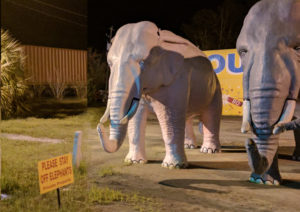 Our March 25 mystery, “Not for climbing purposes,” got two kinds of guesses. Some folks thought the pink and gray elephants were at South of the Border near Dillon on Interstate 95. Great guess. Unfortunately, they were wrong – although a pink elephant really is the kind of thing that should be at the attraction. Others correctly guessed Papa Joe’s Fireworks in Hardeeville near the other end of the interstate (exit 5) in South Carolina. Thanks to Charles Boyd of Hanahan for sending us the photo.
Our March 25 mystery, “Not for climbing purposes,” got two kinds of guesses. Some folks thought the pink and gray elephants were at South of the Border near Dillon on Interstate 95. Great guess. Unfortunately, they were wrong – although a pink elephant really is the kind of thing that should be at the attraction. Others correctly guessed Papa Joe’s Fireworks in Hardeeville near the other end of the interstate (exit 5) in South Carolina. Thanks to Charles Boyd of Hanahan for sending us the photo.
Congratulations to those who correctly identified the elephants: George Graf of Palmyra, Va.; Chris Brooks of Mount Pleasant; Marnie Huger of Richmond, Va.; and Bill Segars of Hartsville.
Graf provided this information on the elephants from atlasobscura.com: “They are nicknamed Thelma and Louise and they’re a well-known landmark on US 17. Papa Joe himself purchased the pair in Alabama and had them shipped all the way to South Carolina. The two matching elephants, one pink, the other gray, regularly receive new coats of paint so they can beckon roadtrippers to Papa Joe’s wares.”
Segars said the pair also were named Big Al and Lizzie. Whatever their names are, they’re fun!
Send us a mystery: If you have a photo that you believe will stump readers, send it along (but make sure to tell us what it is because it may stump us too!) Send it along to editor@charlestoncurrents.com.
HISTORY: Jasper County
S.C. Encyclopedia | Jasper County (656 sq. miles; 2010 pop. 24,777). was formed by an act of the legislature on Jan. 30, 1912, from parts of Beaufort and Hampton Counties, an area which contained much of the old lowcountry parishes of St. Peter’s and St. Luke’s. The southernmost county in the state, Jasper is bound by the Savannah River on the southwest, Hampton County on the north, and Beaufort County on the east. Initially inhabitants wished to name the new county Heyward, in honor of Thomas Heyward, Jr., a signer of the Declaration of Independence who resided in the area. But the effort failed, and the name Jasper was assigned, honoring Revolutionary War hero Sergeant William Jasper. Ridgeland is the county seat.
English and Scots settlers arrived in the region in the late 1600s, where they withstood Spanish attacks and the Yamassee War of 1715 to prevail and lay the foundation for future settlement. In the 1730s, an expedition of Swiss Protestants, led by Jean Pierre Purry, settled on a land grant on the Savannah River (about two miles northwest of the modern town of Hardeeville), which was dubbed Purrysburg. The unhealthy and inconvenient location failed to divert trade away from Charleston or Savannah, however, and the population migrated to other parts of South Carolina and Georgia. Descendants of earlier Scots settlers returned to the area in the mid-1700s, where they established the Euhaw Baptist Church, the first church in the county and one of the earliest Baptist churches in the South. Although Purrysburg was the only eighteenth-century town of note in the Jasper vicinity, future towns traced their origins to the colonial era as well, including Robertville, Coosawhatchie, and Grahamville.
By the 1750s, rice and indigo became the cash crop of choice among the residents of St. Peter’s Parish. Although indigo disappeared after the Revolutionary War, rice remained the foundation of the area’s agricultural wealth through the nineteenth century. By the end of the antebellum era, St. Peter’s Parish was the second most productive rice-growing region of South Carolina. None of this could have happened without the importation of thousands of African slaves, who quickly became a large majority. Old church records indicate that slaves may have outnumbered whites in the region by as much as ten to one before the Civil War.
The future county was the site of considerable military action during the Civil War. Union forces arrived in Beaufort District in November 1861. Over the next several years, they made several unsuccessful incursions into the Jasper region in an effort to cut the railroad line between Charleston and Savannah. In one of the largest of these attempts, in November 1864, a force of 1,400 South Carolina and Georgia Confederates defeated a Union force of about 5,500 in the battle at Honey Hill (about two miles east of Grahamville). In February 1865 the army of William T. Sherman crossed the Savannah River into Jasper County and destroyed entire towns and villages, leaving intact only a few scattered outbuildings, two or three churches, and the former home of Thomas Heyward, Jr.
Soon after the war, the Jasper area was again “invaded” by northerners, this time in the form of industrialists buying up lands as investments and for recreation. Beginning in the 1870s, large private hunting preserves, such as the Pineland Club and Okeetee Club, were organized to provide sport and recreation to well-heeled northern members. By the early twentieth century, timber firms such as the Export Lumber Company of Boston and the Argent Lumber Company had acquired large tracts in the Jasper County region. Much of modern Jasper County remained in the hands of timber interests and affluent northern families, although wealthy southerners recently repurchased a good portion. By the end of the twentieth century, many out-of-state hunt clubs leased these lands for the long deer season and excellent hunting throughout the county, which continued to boost the Jasper economy.
Although not located in Jasper County, the development of Hilton Head Island provided employment opportunities for county residents. Sea Island resort development eventually spilled into the county and new arrivals, including many Hispanics, moved in to take advantage of these new jobs. Interstate 95, which opened in the 1970s, also proved to be a boon to the Jasper economy, with businesses springing up near highway interchanges at Hardeeville, Ridgeland, Coosawhatchie, and Pocataligo. New industries came, as did a third wave of northern “invaders” looking for the ideal place to retire. As a result of this late-twentieth-century growth, land values in parts of Jasper County skyrocketed, with owners of waterfront property finding themselves atop gold mines. During the same period, Jasper lost two railroads and all of its sawmills. Most farm acreage was devoted to pulpwood. However, the overall standard of living increased and Jasper boosters believed their county was truly on the move.
Notable residents have included Daniel Heyward, an eighteenth-century entrepreneur; his son Thomas Heyward, Jr., signer of the Declaration of Independence; General Henry Martyn Robert, author of Robert’s Rules of Order; Mary Ellis, the first female elected to the South Carolina Senate; Air Force General Jacob Edward Smart, the second South Carolina native to achieve four stars; and Air Force General Lloyd Newton, the first African American from South Carolina to receive his fourth star and a former member of the Air Force’s Thunderbirds flying team.
— Excerpted from an entry Wofford Malphrus. See full discussion here. This entry may not have been updated since 2006. To read more about this or 2,000 other entries about South Carolina, check out The South Carolina Encyclopedia, published in 2006 by USC Press. (Information used by permission.)
CALENDAR: Pets to be focus of special Charleston Museum exhibition
![]() Staff reports | The Charleston Museum on April 8 will open In the Company of Animals: Pets of Charleston, in the Lowcountry Image Gallery. The exhibition of 18 black-and-white photographs that chronicle the relationship Charlestonians have had with their pets since the late 1800s will run through the end of the year. .
Staff reports | The Charleston Museum on April 8 will open In the Company of Animals: Pets of Charleston, in the Lowcountry Image Gallery. The exhibition of 18 black-and-white photographs that chronicle the relationship Charlestonians have had with their pets since the late 1800s will run through the end of the year. .
According to the museum, animals have always been part of a human’s everyday life, whether worshiped, hunted for food or used as a means of transportation or labor. Over the years, this relationship has evolved into one of companionship. Highlighting photographers such as Morton B. Paine, Franklin Frost Sams, and Chansonetta Stanley Emmons, this photographic exhibition will put on view how Charlestonians spent their time in the company of animals.
This exhibit is free for Museum members and free with admission to The Charleston Museum. For more information, visit CharlestonMuseum.org.
Ahead on the calendar:
CSO League’s 2019 Designer Showhouse: Through April 28, 16 Rutledge Ave., Charleston. An elegant 1903 high-style Queen Anne Victorian house on Rutledge Avenue near Colonial Lake will be featured as the 42nd annual designer showhouse for the Charleston Symphony Orchestra League. Read more here in our March 18 story. The house, as well as a SCORE pop-up shop with specially-curated items, will be open 10 a.m. to 4 p.m., Monday through Saturday, and 1 p.m. to 4 p.m. on Sundays, except on Easter. Tickets at the door will be available beginning March 27 for $25 each.
The City Luminous exhibition: Through May 5, City Gallery, 34 Prioleau Street, Joe Riley Waterfront Park, Charleston. The City of Charleston Office of Cultural Affairs will present The City Luminous: Architectures of Hope in an Age of Fear. Curated by the two College of Charleston professors, the exhibition assembles architectural installations and images designed to suggest a hopeful way forward for the world’s fractured communities.
Events at the Gaillard. Check out these awesome coming events at the Charleston Gaillard Center, 95 Calhoun St., Charleston:
April 11, 7:30 p.m.: Les Ballets Trockadero de Monte Carlo, a group of ballet enthusiasts for the purpose of presenting a playful, entertaining view of traditional, classical ballet in parody.
April 19 and 20, 7:30 p.m.: Russian Romantics. Beloved pianist Joyce Yang returns to Charleston to close out the symphony season with a night of Russian romantic music.
Lowcountry Cajun Festival: Noon to 6 p.m., April 7, James Island County Park, James Island. The 28th annual festival returns with a full day of Zydeco music, authentic Cajun and Creole food, children’s activities and more! Charleston’s best Cajun restaurants, caterers and food trucks will cook up a variety of delicious foods. For a band line-up and more, visit: CharlestonCountyParks.com.
Books for Bier: 5:30 p.m. to 8 p.m., April 9, Bay Street Biergarten, 549 East Bay St., Charleston. Charleston Friends of the Library will celebrate National Library Week by partnering with Bay Street Biergarten to give adults a free beer when they donate a gently-used book (limited to one beer per adult). Kids who donate a children’s book will get a free root beer. More info.
The Lion in Winter: Several performances, April 11 to April 27, Threshold Repertory Theatre, 84 1/2 Society St., Charleston. The Lion in Winter by James Goldman is a modern-day classic often described as a medieval Who’s Afraid of Virginia Woolf? Comedic in tone and dramatic in action, the play tells the story of the Plantagenet family, which is locked in a free-for-all of competing ambitions to inherit a kingdom. Tickets are $25 for adults, $20 for seniors and $15 for students. Purchase tickets at www.thresholdrep.org.
Movie night in Allan Park: 6:30 p.m. to 9:30 p.m., April 12, 365 Ashley Ave., Charleston. The Charleston Parks Conservancy will screen “Trolls” at Allan Park as a free family movie. Games and activities will ensue before the screening after dark. Food trucks will be on site. The event is sponsored by the Hampton Park Terrace Neighborhood Association. Register online for free tickets.
Shred it. 9 a.m. to noon, April 13 at three locations. You can bring confidential documents to three locations for free, secure, on-site shredding provided by the Charleston County Environmental Management Department. Locations: North Charleston City Hall, 2500 City Hall Ln, North Charleston; Mount Pleasant DMV, 1189 Sweetgrass Basket Pkwy, Mount Pleasant; and Signal Point Road Convenience Center, 1716 Signal Point Rd, West Ashley. No commercial business material will be accepted. This is a shred event only; no other items will be accepted. The events is rain or shine.
Charleston Outdoor Fest: April 13 to April 14, James Island County Park. The event features a multitude of outdoor recreation activities available for attendees to explore in a festival setting. Event attendees can try their hand at paddlesports like kayaking, canoeing, and stand up paddleboarding, in the calm waters of James Island County Park’s lake with boats and equipment available on site. More info.
Hat Ladies’ Easter Promenade: 11 a.m. April 20, corner of Broad and Meeting streets, Charleston. Join the Hat Ladies of Charleston for the elegant tradition of honoring the holiday season wearing beautiful hats during a stroll down Broad Street to East Bay Street and back. Free.
DigSouth: April 24 to April 26, Charleston Gaillard Center, Calhoun St., Charleston. More than 2,000 tech and business leaders will blow into Charleston for the DigSouth Tech Summit, an annual event that serves as the South’s essential tech, business and marketing experience. It offers 150 executive-level speakers from leading global brands, fast-growth startups and the media — plus top investors. To learn more about this year’s event, click here.
Early morning bird walks at Caw Caw: 8:30 a.m. every Wednesday and Saturday, Caw Caw Interpretive Center, Ravenel. You can learn about habitats and birds, butterflies and other organisms in this two-hour session. Registration not required, but participants are to be 15 and up. $10 per person or free to Gold Pass holders. More: http://www.CharlestonCountyParks.com.
AREA MARKETS
WEDNESDAYS. Starting April 24 at 3 p.m. and lasting each Wednesday through 7 p.m., a West Ashley Farmers Market will be held through Oct. 2 in Ackerman Park off Sycamore Avenue in West Ashley. More.
FRIDAYS/SATURDAYS: Night Market. Every Friday and Saturday from 6:30 p.m. to 10:30 p.m. for the rest of the year, you can shop with 108 vendors, including artists and craftsmen, at the night market on Market Street between East Bay and Church streets. It’s more than four blocks of local shopping and fun. Free.
SATURDAYS: Johns Island Farmers Market operates each Saturday from 9:30 a.m. to 1:30 p.m. year-round with more than 50 local farmers and vendors, food trucks, music and more. The market is located on the campus of Charleston Collegiate School, 2024 Academy Road, Johns Island.
SATURDAYS: The Charleston Farmers Market opens 8 a.m. April 13 in Marion Square and will remain open for six hours each Saturday through Nov. 30. More info.
- If you have an event to list on our calendar, please send it to feedback@charlestoncurrents.com for consideration. The calendar is updated weekly on Mondays.
If you like what you’ve been reading, how about considering a contribution so that we can continue to providing you with good news about Charleston and the Lowcountry. Interested? Just click the image below.
OUR UNDERWRITERS
Charleston Currents is an underwriter-supported weekly online journal of good news about the Charleston area and Lowcountry of South Carolina.
- Meet our underwriters
- To learn more about how your organization or business can benefit, click here to contact us. Or give us a holler on the phone at: 843.670.3996.
OUR TEAM
Charleston Currents offers insightful community comment and good news on events each week. It cuts through the information clutter to offer the best of what’s happening locally.
- Mailing address: P.O. Box. 22261 | Charleston, SC 29413
- Phone: 843.670.3996
Charleston Currents is provided to you weekly by:
- Editor and publisher: Andy Brack, 843.670.3996
- Contributing editor, common good, Fred Palm
- Contributing editor, money: Kyra Morris
- Contributing editor, Palmetto Poem: Marjory Wentworth
- Contributing editor, real estate: Digit Matheny
- Contributing photographer: Rob Byko
SUBSCRIBE FOR FREE
Subscriptions to Charleston Currents are free.
- Click here to subscribe.
- Unsubscribe. We don’t want to lose you as a reader of Charleston Currents, but if you must unsubscribe, you will have to do it through the email edition you receive. Just go to the bottom of any of your weekly newsletters and click the “unsubscribe” function. If that doesn’t work, please send us an email with the word “unsubscribe” in the subject line.
- © 2008-2019, Statehouse Report, LLC. All rights reserved. Charleston Currents is published every Monday by Statehouse Report LLC, PO Box 22261, Charleston, SC 29413.


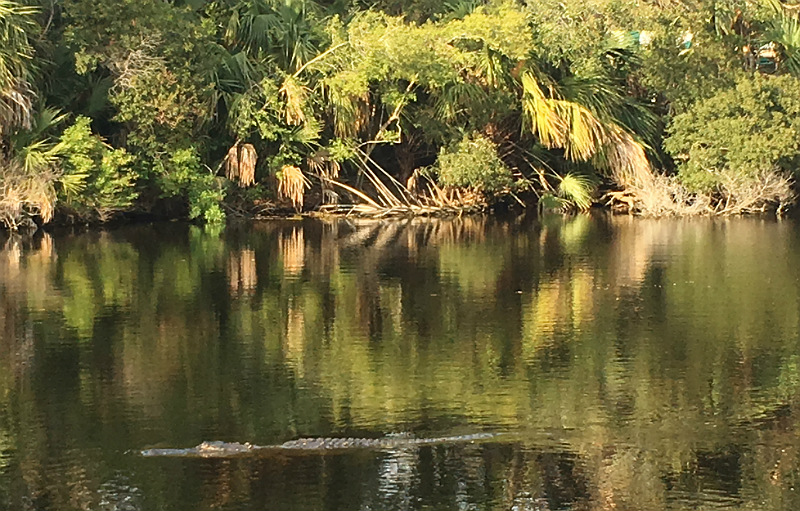



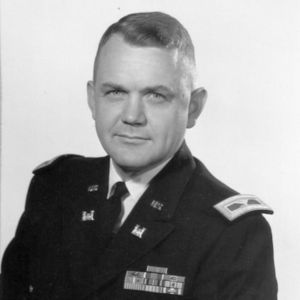
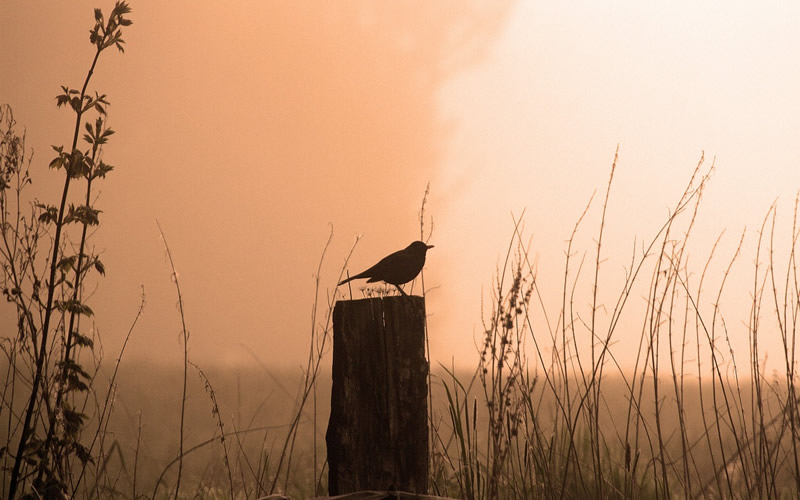
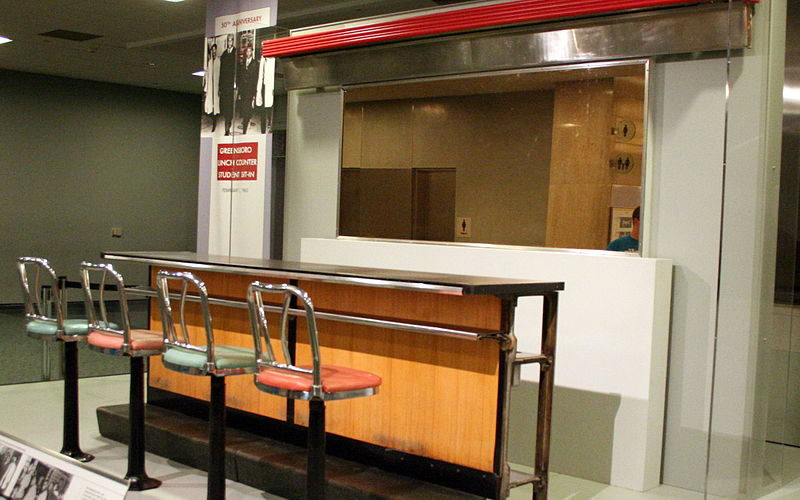

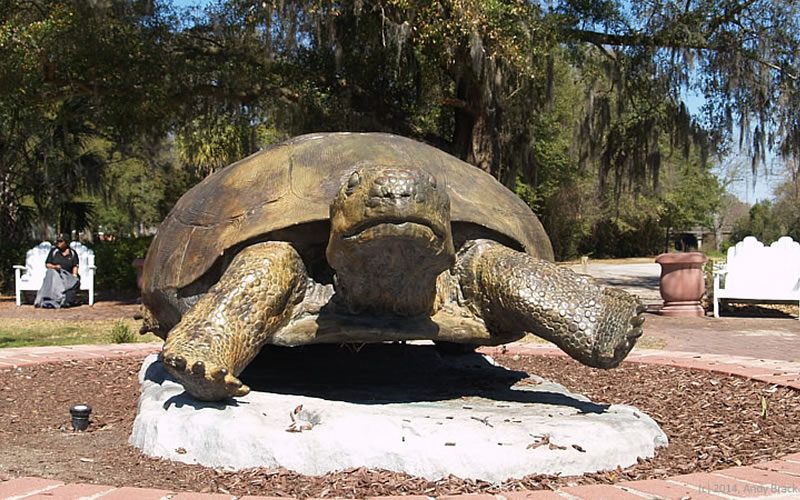

 We Can Do Better, South Carolina!
We Can Do Better, South Carolina!
























